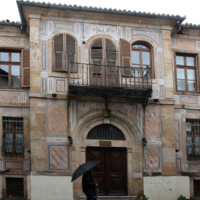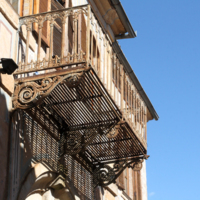Mansion Anna Kaloudis - Kougioumtzoglou
Dublin Core
Title
Mansion Anna Kaloudis - Kougioumtzoglou
Language
en
Identifier
XNP.01
Is Part Of
POI Item Type Metadata
Latitude
41.143301
Longitude
24.888072
WebContent
The mansion was built in 1877 by the tobacco trader Stavros Hatzistavros or else called Hemikoglou Tzamiha in order to serve as a residence. The date of construction can be seen in the inscription of a wall painting which is over the door at the main balcony (exostis). On Antika and Orpheus streets two gates have been built which allow access to the mansion. Thus, both sides of the building are used, having a second separate entrance, except for the central one due to the needs of a modern house of that era. The second entrance leads to the ground floor where there is a terrace. Description of Architecture: The building is remarkable for its architecture which was influenced by the European trends of that era. Special characteristics are the masonry with carved local granite, the intense exterior paintings throughout the building and the bevel formed in the corner. Furthermore, the vertical axis of the entrance protrudes to emphasize the dominant external aspect of the building which is the entrance and the balcony. The protrusion is used for additional lighting, ventilation and provides tenants with bigger view. The architectural design also emphasizes the main aspect of the building with the arched lintels which are found not only at the gate on Antika Street but also at the windows and the balcony door whereas the rest of the openings have a rectangular shape. Inside the building, the rooms are extending around a central lounge. You can notice the painted decoration, the wooden floors and the wooden ceilings with structural peculiarities. Wood is a local building material and, according to the architecture of the time, is used both for the internal coating and for the construction of the internal double staircase. A particularly noteworthy element of the building’s structure is the wooden ceiling of the southeast corner room on the second floor. The wood carved “string” of the frame, which runs around the entire ceiling, is perforated to enable ventilation and air extraction from the roof. There are other buildings in Xanthi where the forged iron bars are from local workshops. In this building the typical beautiful ironwork of cast iron is likely to be of French origin. It protects the openings of the semi-basement and ground floor but they are also used for the entire structure and shape of the balcony (exostis). Inside the building, the ending of the double staircase leads upstairs to the door of the balcony (exostis) and to a reception area which communicates with the other rooms upstairs. The large openings of the balcony door and widows provide the communal room upstairs with plenty of light. Over time: About one hundred years after the construction of the building, the granddaughter and heir of Stavros Hekimoglou, Anna Kaloudi, daughter of Polixeni Hekimoglou and Panteli Kougioumtzoglou, donates the mansion to the House of Letters and Fine Arts of the Municipality of Xanthi in 1971. The only photo of Anna Kaloudi. On the back there is a dedication:”To my beloved Kostas and Evagelini as an indication of brotherly love.Xanthi, 16 of February 1908, Anna P.Kougioumtzoglou”. Cited from the book of Thomas Exarch, “Hipirotes in Xanthi ”in 2002. How it operates today: The building was restored in 1998. From that time until today, it houses the municipal services of Xanthi. In the picture you can see the surroundings from the small triangular roof, created above the entrance on the Orpheus street. The white colored building, visible in the background is the Municipal Gallery.
Entrance
Characterization
ATH
Files
Collection
Citation
“Mansion Anna Kaloudis - Kougioumtzoglou,” iGuide Repo, accessed December 15, 2025, http://ubuntu01.ceti.gr/omeka/items/show/784.













